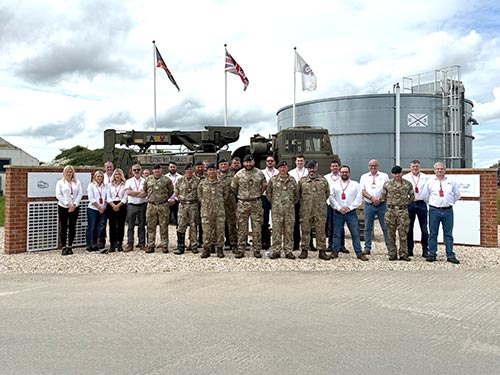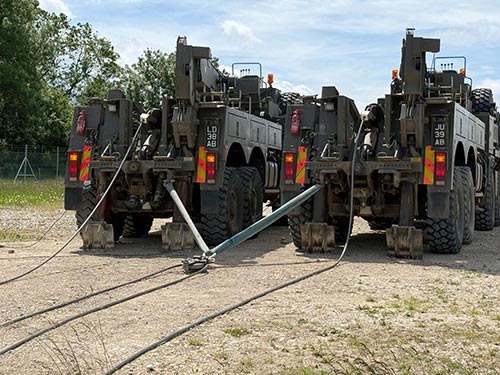At the end of May, a group of EKA staff visited MOD Lyneham for a day hosted by the Recovery Training Wing and the REME Museum. REME – the Royal Electrical and Mechanical Engineers – is the British Army corps responsible for keeping equipment in fighting order and includes the highly skilled recovery mechanics who operate many of the platforms EKA supports.
This visit was designed to strengthen our long-standing relationship with REME’s recovery community, give our team more exposure into modern military recovery operations, and connect with the next generation of tradesmen currently training at Lyneham.
The Recovery Training Wing is a key touchpoint for EKA. It’s where REME soldiers train to become expert Recovery Mechanics, and many of the platforms we have contributed to designing, maintaining or supporting are used daily by those posted there. With a new Artificer Sergeant Major (ASM) in post, the visit also offered a valuable opportunity to introduce EKA’s wider team and reaffirm our ongoing commitment to the trade.

Recovery Mechanic Memorial at Lyneham
After travelling down from Towcester, our group began the day with a guided visit to a lesser-known section of the REME Museum – an off-site vehicle storage hangar not normally open to the public. There, we were shown around a fascinating collection of historic military vehicles, including several with a direct connection to EKA.
EKA’s Rich History
Among the exhibits were early Volvo, Scammell and Foden recovery vehicles – some of the first platforms we were involved in. For those newer to the company, it was a powerful reminder of the long-standing role EKA has played in British military recovery. For longer-serving colleagues, including Andy Kelly, Operations Director at EKA, it was a chance to revisit the legacy platforms that helped shape our engineering direction.
Following the museum tour, we returned to the main camp and were invited to lunch at the Sergeants’ and Warrant Officers’ Mess, thanks to a kind offer from WO1 Lord, the Regimental Sergeant Major. After lunch, we visited the recovery memorial – honouring members of the Recovery Mechanic trade – and then made our way to the hangars and training area to observe equipment in use.
Class 1 Recovery Mechanics

Two SVRs in a W-pull configuration
A particular highlight was the chance to witness a Class 1 assessment involving a ’W pull’ using two SVRs in parallel. This demonstration brought the SVRs into a configuration where they can achieve their maximum combined rated pull of 100 tonnes. Observing the SVR in action added valuable context for the team, helping connect design, engineering and maintenance to the real-world application.
Equally valuable was the time we spent with REME’s up-and-coming tradesmen and women – the soldiers and junior NCOs who are training to become the next generation of recovery experts. These informal conversations offered direct insight into evolving user needs and operational challenges, helping guide future design and development. For our engineering and project teams, that kind of input is vital to ensuring our systems meet the realities of use in the field.
We also had the opportunity to view the CRARRV (Challenger Armoured Repair and Recovery Vehicle) and Warrior variants, further reinforcing the relevance of our work. EKA supported the introduction and integration of the TR2000 Main Recovery Winch into the CRARRV and has supported it for many years, including winch servicing and now the manufacture of replacement components as some parts become obsolete. It’s a good example of how our technical capabilities continue to evolve in line with operational requirements.
EKA’s Managing Director, Michael Keech, said: “The day delivered on every key aim: strengthening our working relationship with the Recovery Training Wing, creating space for meaningful conversations with future recovery operators, and giving our team a closer understanding of the environment our equipment is designed for.
“We’d like to thank everyone who helped host the visit, including WO1 Dan Martin, Sgt Jamie Owen, Rick Henderson from the REME Museum, and WO1 Lord. Their support, hospitality and openness were genuinely appreciated by all who attended.
“We look forward to continuing to work closely with REME and the wider recovery community, ensuring our systems continue to support the trade effectively – now and in the years ahead.”




